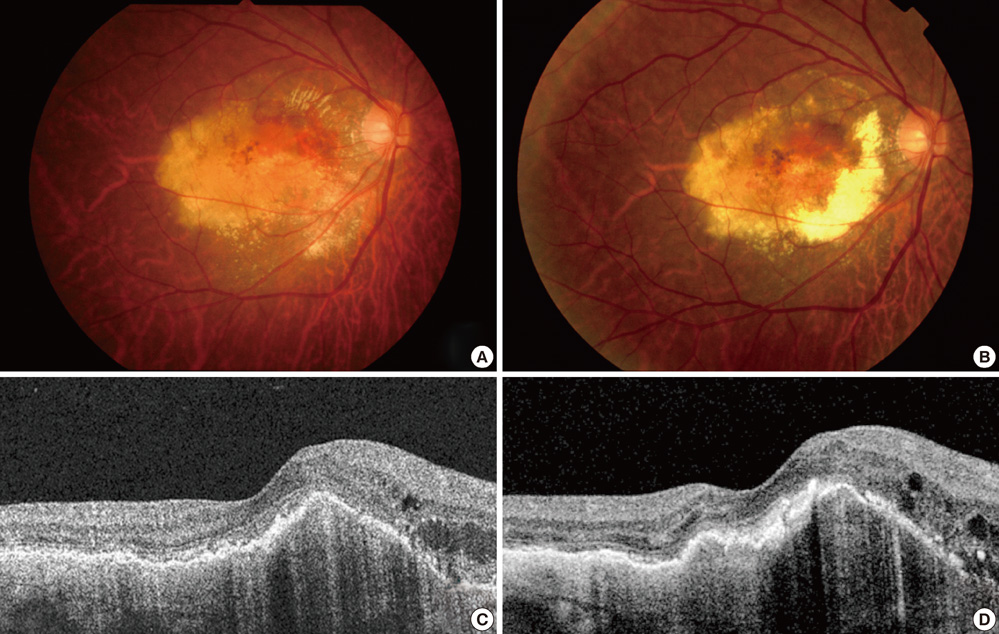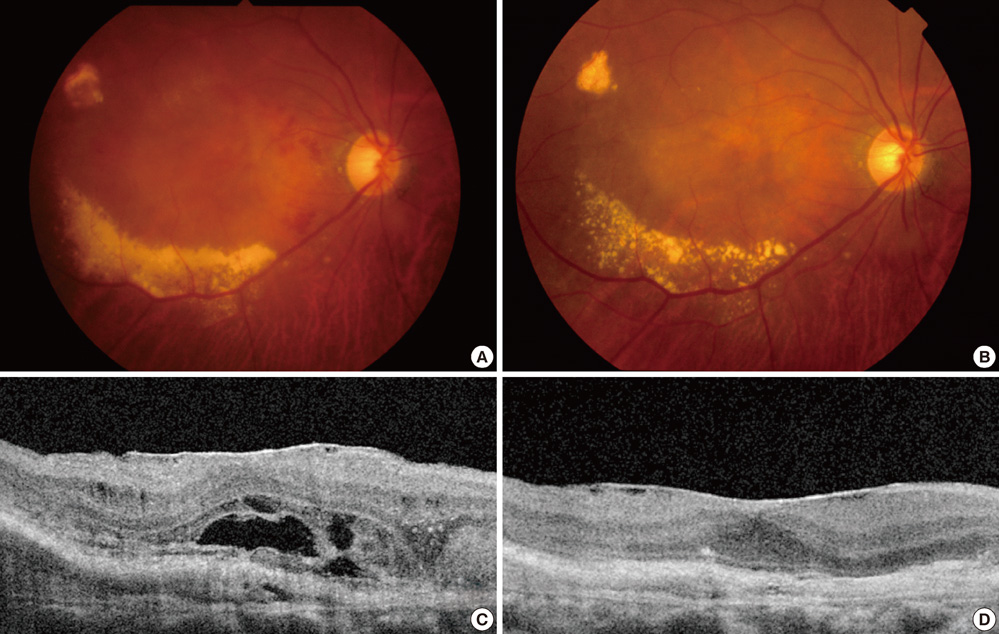J Korean Med Sci.
2013 May;28(5):769-774. 10.3346/jkms.2013.28.5.769.
Current Smoking Is Associated with a Poor Visual Acuity Improvement after Intravitreal Ranibizumab Therapy in Patients with Exudative Age-Related Macular Degeneration
- Affiliations
-
- 1Department of Ophthalmology, Seoul National University Hospital, Seoul National University College of Medicine, Seoul, Korea. hgonyu@snu.ac.kr
- 2Department of Ophthalmology, Kangbuk Samsung Hospital, Sungkyunkwan University School of Medicine, Seoul, Korea.
- KMID: 1777567
- DOI: http://doi.org/10.3346/jkms.2013.28.5.769
Abstract
- In this study, the risk factors that may influence visual improvement after intravitreal ranibizumab (IVR) treatment for exudative age-related macular degeneration (AMD) were examined. From 2008 to 2012, 420 patients (448 eyes) with exudative AMD were prospectively registered at Seoul National University Hospital. From this group of patients, 125 eyes were included in this study. All patients were treated with 3 consecutive IVR injections. The visual acuity (VA) was evaluated at baseline and 1 month after the third ranibizumab injection. To evaluate the risk factors associated with VA improvement after IVR, patient demographic data and systemic risk factors were analyzed. Patients were divided into a poor VA improvement group and a good VA improvement group, with reference to the median visual improvement in all eyes. Among 125 eyes, 66 eyes (52.8%) were included in the responder group and 59 eyes (47.2%) in the non-responder group. The median VA improvement after 3 monthly ranibizumab injections was -0.05 logMAR. Multivariate analyses revealed that current smoking (adjusted OR, 7.540; 95% CI, 1.732-32.823) was independently associated with poor VA improvement after IVR treatment for exudative AMD. In conclusion, cigarette smoking is an independent risk factor for lower VA gains with IVR treatment for exudative AMD.
MeSH Terms
-
Aged
Antibodies, Monoclonal, Humanized/*therapeutic use
Female
Humans
Intravitreal Injections
Macular Degeneration/*drug therapy/radiography
Male
Middle Aged
Multivariate Analysis
Odds Ratio
Prospective Studies
Risk Factors
*Smoking
Tomography, Optical Coherence
Visual Acuity/*physiology
Antibodies, Monoclonal, Humanized
Figure
Reference
-
1. Friedman DS, O'Colmain BJ, Muñoz B, Tomany SC, McCarty C, de Jong PT, Nemesure B, Mitchell P, Kempen J. Eye Diseases Prevalence Research Group. Prevalence of age-related macular degeneration in the United States. Arch Ophthalmol. 2004. 122:564–572.2. Kliffen M, Sharma HS, Mooy CM, Kerkvliet S, de Jong PT. Increased expression of angiogenic growth factors in age-related maculopathy. Br J Ophthalmol. 1997. 81:154–162.3. Boyer DS, Antoszyk AN, Awh CC, Bhisitkul RB, Shapiro H, Acharya NR. MARINA Study Group. Subgroup analysis of the MARINA study of ranibizumab in neovascular age-related macular degeneration. Ophthalmology. 2007. 114:246–252.4. Kaiser PK, Brown DM, Zhang K, Hudson HL, Holz FG, Shapiro H, Schneider S, Acharya NR. Ranibizumab for predominantly classic neovascular age-related macular degeneration: subgroup analysis of first-year ANCHOR results. Am J Ophthalmol. 2007. 144:850–857.5. Fung AE, Lalwani GA, Rosenfeld PJ, Dubovy SR, Michels S, Feuer WJ, Puliafito CA, Davis JL, Flynn HW Jr, Esquiabro M. An optical coherence tomography-guided, variable dosing regimen with intravitreal ranibizumab (Lucentis) for neovascular age-related macular degeneration. Am J Ophthalmol. 2007. 143:566–583.6. Mitchell P, Korobelnik JF, Lanzetta P, Holz FG, Prünte C, Schmidt-Erfurth U, Tano Y, Wolf S. Ranibizumab (Lucentis) in neovascular age-related macular degeneration: evidence from clinical trials. Br J Ophthalmol. 2010. 94:2–13.7. McKibbin M, Ali M, Bansal S, Baxter PD, West K, Williams G, Cassidy F, Inglehearn CF. CFH, VEGF and HTRA1 promoter genotype may influence the response to intravitreal ranibizumab therapy for neovascular age-related macular degeneration. Br J Ophthalmol. 2012. 96:208–212.8. Nischler C, Oberkofler H, Ortner C, Paikl D, Riha W, Lang N, Patsch W, Egger SF. Complement factor H Y402H gene polymorphism and response to intravitreal bevacizumab in exudative age-related macular degeneration. Acta Ophthalmol. 2011. 89:e344–e349.9. Wickremasinghe SS, Xie J, Lim J, Chauhan DS, Robman L, Richardson AJ, Hageman G, Baird PN, Guymer R. Variants in the APOE gene are associated with improved outcome after anti-VEGF treatment for neovascular AMD. Invest Ophthalmol Vis Sci. 2011. 52:4072–4079.10. Age-Related Eye Disease Study Research Group. Risk factors associated with age-related macular degeneration: a case-control study in the agerelated eye disease study: Age-Related Eye Disease Study Report Number 3. Ophthalmology. 2000. 107:2224–2232.11. Seddon JM, Willett WC, Speizer FE, Hankinson SE. A prospective study of cigarette smoking and age-related macular degeneration in women. JAMA. 1996. 276:1141–1146.12. Khan JC, Thurlby DA, Shahid H, Clayton DG, Yates JR, Bradley M, Moore AT, Bird AC. Genetic Factors in AMD Study. Smoking and age related macular degeneration: the number of pack years of cigarette smoking is a major determinant of risk for both geographic atrophy and choroidal neovascularisation. Br J Ophthalmol. 2006. 90:75–80.13. Risk factors for neovascular age-related macular degeneration: the Eye Disease Case-Control Study Group. Arch Ophthalmol. 1992. 110:1701–1708.14. Seddon JM, George S, Rosner B. Cigarette smoking, fish consumption, omega-3 fatty acid intake, and associations with age-related macular degeneration: the US Twin Study of Age-Related Macular Degeneration. Arch Ophthalmol. 2006. 124:995–1001.15. Tomany SC, Wang JJ, Van Leeuwen R, Klein R, Mitchell P, Vingerling JR, Klein BE, Smith W, De Jong PT. Risk factors for incident age-related macular degeneration: pooled findings from 3 continents. Ophthalmology. 2004. 111:1280–1287.16. Conklin BS, Zhao W, Zhong DS, Chen C. Nicotine and cotinine up-regulate vascular endothelial growth factor expression in endothelial cells. Am J Pathol. 2002. 160:413–418.17. Heeschen C, Jang JJ, Weis M, Pathak A, Kaji S, Hu RS, Tsao PS, Johnson FL, Cooke JP. Nicotine stimulates angiogenesis and promotes tumor growth and atherosclerosis. Nat Med. 2001. 7:833–839.18. Ni Dhubhghaill SS, Cahill MT, Campbell M, Cassidy L, Humphries MM, Humphries P. The pathophysiology of cigarette smoking and age-related macular degeneration. Adv Exp Med Biol. 2010. 664:437–446.19. Suñer IJ, Espinosa-Heidmann DG, Marin-Castano ME, Hernandez EP, Pereira-Simon S, Cousins SW. Nicotine increases size and severity of experimental choroidal neovascularization. Invest Ophthalmol Vis Sci. 2004. 45:311–317.20. Vingerling JR, Dielemans I, Bots ML, Hofman A, Grobbee DE, de Jong PT. Age-related macular degeneration is associated with atherosclerosis: the Rotterdam Study. Am J Epidemiol. 1995. 142:404–409.21. Moutray T, Alarbi M, Mahon G, Stevenson M, Chakravarthy U. Relationships between clinical measures of visual function, fluorescein angiographic and optical coherence tomography features in patients with subfoveal choroidal neovascularisation. Br J Ophthalmol. 2008. 92:361–364.22. Unver YB, Yavuz GA, Bekiroglu N, Presti P, Li W, Sinclair SH. Relationships between clinical measures of visual function and anatomic changes associated with bevacizumab treatment for choroidal neovascularization in age-related macular degeneration. Eye (Lond). 2009. 23:453–460.
- Full Text Links
- Actions
-
Cited
- CITED
-
- Close
- Share
- Similar articles
-
- Clinical Changes after Switching from Ranibizumab/Aflibercept to Bevacizumab in Exudative Age-related Macular Degeneration
- Intravitreal Anti-vascular Endothelial Growth Factor for Typical Exudative Age-related Macular Degeneration in Eyes with Good Baseline Visual Acuity
- Macular Hole Following Intravitreal Ranibizumab Injections for Choroidal Neovascularization
- Clinical Outcomes of Aflibercept Treatment for Treatment-naive Exudative Age-related Macular Degeneration
- Incidence of New Choroidal Neovascularization in Fellow Eyes of Patients Treated for Age-Related Macular Degeneration



